
Siboglinidae is a family of polychaete annelid worms whose members made up the former phyla Pogonophora and Vestimentifera. They are composed of about 100 species of vermiform creatures and live in thin tubes buried in sediments (Pogonophora) or in tubes attached to hard substratum (Vestimentifera) at ocean depths from 100 to 10,000 m. They can also be found in association with hydrothermal vents, methane seeps, sunken plant material, or whale carcasses.

The Polychaeta, also known as the bristle worms or polychaetes, are a paraphyletic class of annelid worms, generally marine. Each body segment has a pair of fleshy protrusions called parapodia that bear many bristles, called chaetae, which are made of chitin. More than 10,000 species are described in this class. Common representatives include the lugworm and the sandworm or clam worm Alitta.

Teleostei, members of which are known as teleosts, is by far the largest infraclass in the class Actinopterygii, the ray-finned fishes, containing 96% of all extant species of fish. Teleosts are arranged into about 40 orders and 448 families. Over 26,000 species have been described. Teleosts range from giant oarfish measuring 7.6 m (25 ft) or more, and ocean sunfish weighing over 2 t, to the minute male anglerfish Photocorynus spiniceps, just 6.2 mm (0.24 in) long. Including not only torpedo-shaped fish built for speed, teleosts can be flattened vertically or horizontally, be elongated cylinders or take specialised shapes as in anglerfish and seahorses.
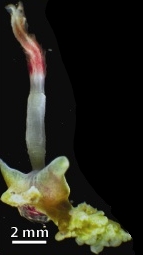
Osedax is a genus of deep-sea siboglinid polychaetes, commonly called boneworms, zombie worms, or bone-eating worms. Osedax is Latin for "bone-eater". The name alludes to how the worms bore into the bones of whale carcasses to reach enclosed lipids, on which they rely for sustenance. They utilize specialized root tissues for bone-boring. It is possible that multiple species of Osedax reside in the same bone. Osedax worms are also known to feed on the collagen itself by making holes in the whale's skeletal structure. These holes can also serve as a form of protection from nearby predators.
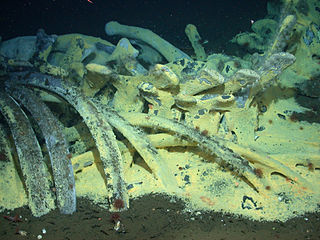
A whale fall occurs when the carcass of a whale has fallen onto the ocean floor at a depth greater than 1,000 m (3,300 ft), in the bathyal or abyssal zones. On the sea floor, these carcasses can create complex localized ecosystems that supply sustenance to deep-sea organisms for decades. This is unlike in shallower waters, where a whale carcass will be consumed by scavengers over a relatively short period of time. Whale falls were first observed in the late 1970s with the development of deep-sea robotic exploration. Since then, several natural and experimental whale falls have been monitored through the use of observations from submersibles and remotely operated underwater vehicles (ROVs) in order to understand patterns of ecological succession on the deep seafloor.

Xenoturbella is a genus of very simple bilaterians up to a few centimeters long. It contains a small number of marine benthic worm-like species.

The Monterey Bay Aquarium Research Institute (MBARI) is a private, non-profit oceanographic research center in Moss Landing, California. MBARI was founded in 1987 by David Packard, and is primarily funded by the David and Lucile Packard Foundation. Christopher Scholin serves as the institute's president and chief executive officer, managing a work force of approximately 220 scientists, engineers, and operations and administrative staff.
Chasmodes saburrae, the Florida blenny, is a species of combtooth blenny found in the western central Atlantic Ocean, around the coast of the United States.
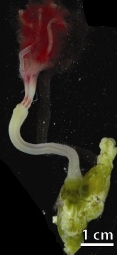
Osedax rubiplumus is a species of bathypelagic Polychaetes that is reported to sustain itself on the bones of dead whales.
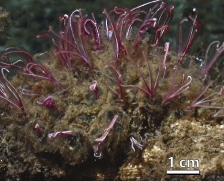
Osedax frankpressi is a species of bathypelagic polychaete worm that lives on the seabed and sustains itself on the bones of dead whales. It can be found in the East North Pacific Ocean. The specific epithet is named in honor of Frank Press "for his distinguished service to science".
Osedax japonicus is a species of bathypelagic polychaete tube worm that lives at great depths on the seabed and is able to sustain itself on the bones of a dead whale. It was first described in 2006 from a sunken sperm whale carcase near Kyushu, Japan.
Osedax priapus is a species of bathypelagic polychaetes that is reported to sustain itself on the bones of dead whales.
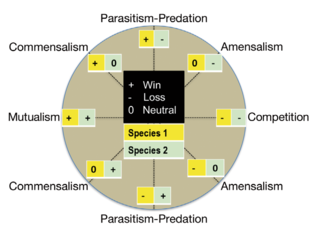
Microbial symbiosis in marine animals was not discovered until 1981. In the time following, symbiotic relationships between marine invertebrates and chemoautotrophic bacteria have been found in a variety of ecosystems, ranging from shallow coastal waters to deep-sea hydrothermal vents. Symbiosis is a way for marine organisms to find creative ways to survive in a very dynamic environment. They are different in relation to how dependent the organisms are on each other or how they are associated. It is also considered a selective force behind evolution in some scientific aspects. The symbiotic relationships of organisms has the ability to change behavior, morphology and metabolic pathways. With increased recognition and research, new terminology also arises, such as holobiont, which the relationship between a host and its symbionts as one grouping. Many scientists will look at the hologenome, which is the combined genetic information of the host and its symbionts. These terms are more commonly used to describe microbial symbionts.

Rubyspira is a genus of deep water sea snails, marine gastropod mollusks unclassified in the family within the superfamily Abyssochrysoidea.

Syllis prolifera is a species of polychaete worm in the family Syllidae. It has a cosmopolitan distribution. It was first described in 1852 by the Russian/German zoologist August David Krohn who gave it the name Syllis prolifera.

Adipicola pelagica is a species of saltwater clam, a marine bivalve mollusc in the family Mytilidae, the mussels. It is a deepwater species and is found attached to the bones and tissues of whales that have died and sunk to the seabed, and sometimes to fragments of decomposing carcases which have sloughed off and floated to the surface.

Neanthes arenaceodentata is a species of marine polychaete worm in the family Nereididae. It occurs in shallow waters in the tropical Atlantic and Pacific Oceans. It has been used in the laboratory in testing the toxicity of marine sediments.
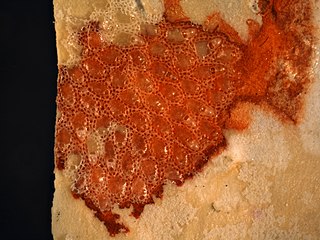
Chorizopora brongniartii is a species of bryozoan in the family Chorizoporidae. It is an encrusting bryozoan, the colonies forming spreading patches. It has a widespread distribution in tropical and temperate seas.
Processa edulis is a species of caridean shrimp found in shallow water in the Atlantic Ocean and the Mediterranean Sea. It mostly inhabits seagrass beds and eelgrass flats, hiding by day and feeding at night. A common name for it is nika shrimp.















